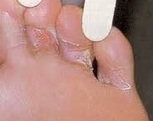Athletes Foot (Tinea Pedis)

What is Athletes Foot.
Athletes Foot (Tinea Pedis) is one of the most prevalent foot infections seen in the general population today. In fact, most people who have Athletes foot aren't even aware they have it! It is caused by a fungal infection that can lead to red, dry, flaking skin, sometimes accompanied by odour, pain, itching or bogginess. The condition usually occurs between the toes or on the soles or sides of the feet. There are many different types of Athletes foot that can affect the feet. More serious cases can cause blisters that itch or weep. It can also be found in toenails which can cause discoloration, flakiness and even the loss of a nail (see fungal toenails). Fungal infections are more common in the elderly and teenage boys and are often passed off as smelly feet, flaky skin or cracking.
Cause of Athletes Foot
Fungal infections like Athletes foot are often contracted from public places especially in warm damp areas such as the gym or in public showers.
Tinea isn't just found on the foot, it can spread to the toenails, or even other parts of the body including, underarms or even the groin. it is for this reason you have to be careful not to spread the infection and get it treated as soon as possible.Treatment of Athlete's foot isn't usually much for a concern, as it is usually treated fairly easily. However, as with any foot condition, those with diabetes and compromised immune systems must be aware that they are more susceptible to developing infections that can lead to more serious medical problems and as such should treat it more seriously.
Treatment
Once you have tinea, it is recommended that you visit your Podiatrist. While most fungal infections can be treated fairly easily, others can be extremely stubborn and difficult to get rid of. In rare cases fungal infections can even become chronic. There are a lot of treatments available out there for fungal infections which include everything from over the counter creams, right through to prescription medications.
Topical:
Topical antifungal agents such as sprays, powders, creams and gels are the most commonly used anti fungal treatments. At Podantics, we suggests that you start with a gel treatment were possible. These gel solutions offer complete contact with the skin unlike powders, and are faster drying than most creams. The most common ingredients in these over the counter products include miconazole nitrate, tolnaftate, and terbinafine. When using topical treatments it is important to keep in mind that you must use these every day and that a course of treatment may be as long as 45 days. We generally recommend that in most situations you continue the use of topical treatments for up to four weeks after the symptoms subside to ensure that the fungus has been completely eliminated.
Keep your feet clean and dry:
Because these fungus love warm moist and dark conditions, it is important to make sure you keep your feet dry and your shoes well aired. In order to help treat this problem, it is import to help control the environment. It is preferable that you wear a shoe that has a breathable upper such as leather. Likewise, it is important that socks are worn as a barrier between the foot and the shoe and are also made from natural fibres. Some synthetic materials such as vinyl can cause extra perspiration creating a moist environment, ideal for fungus to grow in! The part of the foot that has the most moisture naturally is the spaces between the toes so it important to dry thoroughly between these daily. In feet where the toes sit close together, natural perspiration may lead to moistening of the inter-digital spaces despite best attempts to keep these areas dry.
Prevention:
1. Keep your feet, especially the area between your toes, clean and dry.
2. Change your shoes and socks often to help keep your feet dry.
3. Air your shoes regularly & wash bathmats & socks etc in antifungal solutions such as Canesten Hygiene Laundry Rinse.
4. Exfoliate your feet regularly. This helps to remove the excess dead skin and callus on your feet which can build up and encourage the growth of this moisture loving problem. This can be done with either a foot exfoliating scrub cream, or a foot scrubber brush and should be done gently on a weekly basis.
5. Make sure you use thongs (or as the Americans say, flip flops) in public showers or wet areas
6. Stay away from talc on the feet. Instead try dusting your feet daily with specially designed foot powders such as prantal powder that have active ingredients in them to assist with fungal problems.
7. Keep your shower clean and dry. Showers are a perfect breeding ground for tinea and athletes feet. Regular cleaning helps reduce cross infection and reinfection.
Related Articles:
- Fungal Nails (Onychomycosis)
- Blisters
- Common Skin Problems
- Common Nail Problems
- Smelly Feet


